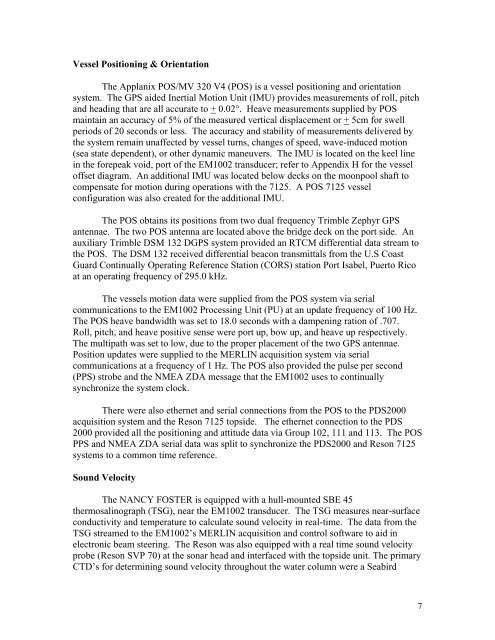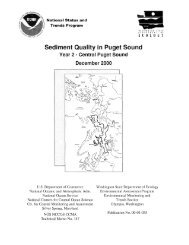Data Acquisition and Processing Report (DAPR) - Center for Coastal ...
Data Acquisition and Processing Report (DAPR) - Center for Coastal ...
Data Acquisition and Processing Report (DAPR) - Center for Coastal ...
Create successful ePaper yourself
Turn your PDF publications into a flip-book with our unique Google optimized e-Paper software.
Vessel Positioning & Orientation<br />
The Applanix POS/MV 320 V4 (POS) is a vessel positioning <strong>and</strong> orientation<br />
system. The GPS aided Inertial Motion Unit (IMU) provides measurements of roll, pitch<br />
<strong>and</strong> heading that are all accurate to + 0.02°. Heave measurements supplied by POS<br />
maintain an accuracy of 5% of the measured vertical displacement or + 5cm <strong>for</strong> swell<br />
periods of 20 seconds or less. The accuracy <strong>and</strong> stability of measurements delivered by<br />
the system remain unaffected by vessel turns, changes of speed, wave-induced motion<br />
(sea state dependent), or other dynamic maneuvers. The IMU is located on the keel line<br />
in the <strong>for</strong>epeak void, port of the EM1002 transducer; refer to Appendix H <strong>for</strong> the vessel<br />
offset diagram. An additional IMU was located below decks on the moonpool shaft to<br />
compensate <strong>for</strong> motion during operations with the 7125. A POS 7125 vessel<br />
configuration was also created <strong>for</strong> the additional IMU.<br />
The POS obtains its positions from two dual frequency Trimble Zephyr GPS<br />
antennae. The two POS antenna are located above the bridge deck on the port side. An<br />
auxiliary Trimble DSM 132 DGPS system provided an RTCM differential data stream to<br />
the POS. The DSM 132 received differential beacon transmittals from the U.S Coast<br />
Guard Continually Operating Reference Station (CORS) station Port Isabel, Puerto Rico<br />
at an operating frequency of 295.0 kHz.<br />
The vessels motion data were supplied from the POS system via serial<br />
communications to the EM1002 <strong>Processing</strong> Unit (PU) at an update frequency of 100 Hz.<br />
The POS heave b<strong>and</strong>width was set to 18.0 seconds with a dampening ration of .707.<br />
Roll, pitch, <strong>and</strong> heave positive sense were port up, bow up, <strong>and</strong> heave up respectively.<br />
The multipath was set to low, due to the proper placement of the two GPS antennae.<br />
Position updates were supplied to the MERLIN acquisition system via serial<br />
communications at a frequency of 1 Hz. The POS also provided the pulse per second<br />
(PPS) strobe <strong>and</strong> the NMEA ZDA message that the EM1002 uses to continually<br />
synchronize the system clock.<br />
There were also ethernet <strong>and</strong> serial connections from the POS to the PDS2000<br />
acquisition system <strong>and</strong> the Reson 7125 topside. The ethernet connection to the PDS<br />
2000 provided all the positioning <strong>and</strong> attitude data via Group 102, 111 <strong>and</strong> 113. The POS<br />
PPS <strong>and</strong> NMEA ZDA serial data was split to synchronize the PDS2000 <strong>and</strong> Reson 7125<br />
systems to a common time reference.<br />
Sound Velocity<br />
The NANCY FOSTER is equipped with a hull-mounted SBE 45<br />
thermosalinograph (TSG), near the EM1002 transducer. The TSG measures near-surface<br />
conductivity <strong>and</strong> temperature to calculate sound velocity in real-time. The data from the<br />
TSG streamed to the EM1002’s MERLIN acquisition <strong>and</strong> control software to aid in<br />
electronic beam steering. The Reson was also equipped with a real time sound velocity<br />
probe (Reson SVP 70) at the sonar head <strong>and</strong> interfaced with the topside unit. The primary<br />
CTD’s <strong>for</strong> determining sound velocity throughout the water column were a Seabird<br />
7







